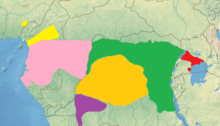Osman-Hill-Mangabe
aus Wikipedia, der freien Enzyklopädie
| Osman-Hill-Mangabe | ||||||||||||
|---|---|---|---|---|---|---|---|---|---|---|---|---|
| Systematik | ||||||||||||
| ||||||||||||
| Wissenschaftlicher Name | ||||||||||||
| Lophocebus osmani | ||||||||||||
| Groves, 1978 |
Die Osman-Hill-Mangabe (Lophocebus osmani) ist eine Primatenart aus der Familie der Meerkatzenverwandten (Cercopithecidae). Sie galt lange Zeit als Unterart der Grauwangenmangabe, wurde 2007 aber in den Artstatus erhoben. Die Art ist zu Ehren des Biologen William Charles Osman Hill (1901–1975) benannt.
Osman-Hill-Mangaben sind schlank gebaute Primaten mit langen Gliedmaßen und einem langen Schwanz. Ihr Fell ist an der Oberseite schwarzbraun gefärbt, die Unterseite ist heller, meist gelbgrau. Der Kopf weist eine langgestreckte Schnauze auf, die langen Backenhaare sind grau oder goldgelb gefärbt. An den Schultern befinden sich lange, rotbraune, mantelähnliche Haare.

Osman-Hill-Mangaben bewohnen Plateaugebiete in Kamerun, sie sind von der Grenze zu Nigeria im Westen bis in die Provinz Est verbreitet. Sie leben in Wäldern und kommen vorrangig in Gebieten über 600 Metern Höhe vor.
Über die Lebensweise dieser Art ist kaum etwas bekannt. Vermutlich ist sie wie die Grauwangenmangabe ein tagaktiver Baumbewohner, der in kleinen Gruppen lebt und sich von Früchten, Nüssen und Kleintieren ernährt.
Auch über den Gefährdungsgrad weiß man nichts. Die IUCN fasst die Art noch mit der Grauwangenmangabe zusammen, hält aber eine dringende Neubewertung für notwendig.
Literatur
[Bearbeiten | Quelltext bearbeiten]- Colin Groves: The Endemic Uganda Mangabey (Lophocebus ugandae), and Other Members of the albigena-Group (Lophocebus). In: Primate Conservation. Nr. 22, 2007, S. 123–128, doi:10.1896/052.022.0112.
- Thomas Geissmann: Vergleichende Primatologie. Springer-Verlag, Berlin u. a. 2003, ISBN 3-540-43645-6.
Weblinks
[Bearbeiten | Quelltext bearbeiten]- Lophocebus albigena in der Roten Liste gefährdeter Arten der IUCN 2011. Eingestellt von: J. F. Oates, C. P. Groves, C. Ehardt, 2008. Abgerufen am 30. Juni 2011. (als Unterart von Lophocebus albigena geführt)
Text is available under the CC BY-SA 4.0 license; additional terms may apply.
Images, videos and audio are available under their respective licenses.
